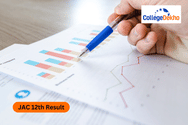CBSE Class 12 Accountancy Syllabus 2023-24 has been published by the board. Students can check the topic-wise detailed syllabus 2023-24 on the official website. Check all the information here!
- CBSE Class 12 Accountancy Syllabus 2023-24 PDF
- CBSE Class 12 Accountancy Syllabus 2023-24 Course structure
- CBSE Accountancy Syllabus for Class 12 2023-24
- CBSE Class 12 Accountancy Syllabus 2023-24: Deleted Topics
- CBSE Class 12 Accountancy Syllabus 2023-24: Question Paper Design
- How to Download CBSE Class 12 Accountancy Syllabus 2023-24?
- CBSE Class 12 Accountancy Syllabus 2023-24 for Practical Examination
- What are the best books for CBSE 12th Accountancy Exam …
- Faqs


Never Miss an Exam Update
CBSE Class 12 Accountancy Syllabus 2023-24: The Central Board of Secondary Education has released the subject-wise curriculum for senior secondary students. The syllabus is divided into 3 parts. The weightage of Part 1 is 60 and 20 each for Part 2, and 3. It must be noted that Part 3 is project work which will include the project file and viva voce. Candidates appearing for accountancy papers should have a good understanding of the fundamental accounting ideas, procedures, and modifications made to prepare and present financial statements in line with the 2013 Companies Act. Students can check the CBSE Class 12 Accountancy curriculum and download it in PDF from the link provided below to get their accounting study plan for a strong start.
Also Read:
| CBSE Class 12 Result 2024 |
|---|
| CBSE Class 12 Grading System 2024 |
| CBSE Class 12 Arts Topper 2024 |
| CBSE Class 12 Commerce Topper 2024 |
| CBSE Class 12 Science Topper 2024 |
| CBSE Class 12 Marksheet 2024 |
CBSE Class 12 Accountancy Syllabus 2023-24 PDF
Understanding the topics covered in the syllabus will help students develop the skills they need to succeed in these fields. For that students can download CBSE Class 12 Accountancy Syllabus 2023-24 pdf
CBSE Class 12 Accountancy Syllabus 2023-24 Course structure
The Class 12 Accountancy curriculum is a detailed and rigorous study. It covers a wide range of topics and requires a strong accounting foundation from the students. The course outline for the CBSE Class 12 Accountancy Syllabus for 2023–24 is shown in the table below.
Units | Topic | Marks |
|---|---|---|
Part A | Accounting for Partnership Firms and Companies | 16 |
Unit 1. Accounting for Partnership Firms | 36 | |
Unit 2. Accounting for Companies | 24 | |
60 | ||
Part B | Financial Statement Analysis | -- |
Unit 3. Analysis of Financial Statements | 12 | |
Unit 4. Cash Flow Statement | 08 | |
20 | ||
Part C | Project Work | 20 |
Project work will include: | -- | |
Project File | 12 Marks | |
Viva Voce | 08 Marks | |
OR | ||
Part B | Computerized Accounting | |
Unit 4. Computerized Accounting | 20 | |
Part C | Practical Work | 20 |
Project work will include: | -- | |
Project File | 12 | |
Viva Voce | 08 | |
CBSE Accountancy Syllabus for Class 12 2023-24
Part A: Accounting for Partnership Firms and Companies
Unit 1: Accounting for Partnership Firms
Partnership: features, Partnership Deed
- The provisions of Indian Partnership Act of 1932 in the absence of a partnership deed.
- Capital accounts: fixed vs. variable. Creating a Profit and Loss Statement Profit distribution among partners and profit assurance are provided through an appropriation account.
- Amounts previously adjusted (for interest on capital, interest on withdrawals, salary, and profit-sharing ratio).
- Goodwill: what it is, how it works, what influences it, and how it is valued using average profit, super profit, and capitalization.
Accounting for Partnership firms - Reconstitution and Dissolution
- Changes to the current partners' profit-sharing ratios, including gaining and sacrificing ratios, accounting for revalued assets and liabilities, reserve treatment, and accumulated profits and losses. creation of the balance sheet and revaluation account.
Admission of a partner
- The effect of the admission of a partner on the change in the profit-sharing ratio, treatment of goodwill (per AS 26), treatment of revaluation of assets and liabilities, treatment of reserves, accumulated profits and losses, adjustment of capital accounts, and preparation of capital, current account, and balance sheet.
Retirement and death of a partner
- Effects on the profit sharing ratio, goodwill treatment (according to AS 26), asset and liability revaluations, adjustments to accumulated profits, losses, and reserves, capital account adjustments, and the creation of capital, current accounts, and balance sheets.
- Creation of the retiring partner's loan account.
- Calculation of the departed partner's profit share up to their passing. preparation of the capital account and the executor's account for the dead partner.
Dissolution of a partnership firm
- Definitions of partnership and partnership firm dissolution and kinds of firm dissolution. Settlement of accounts, preparation of the realization account, and other associated accounts, including the capital accounts of the partners and the cash and bank accounts (with the exception of the piecemeal distribution, sale to a corporation, and insolvency of the partner(s), if any).
Unit-2 Accounting for Companies
- Accounting for Share Capital
- Features and business types.
Shares and share capital
- Kinds and characteristics.
- Equity and preference shares are issued and distributed as part of the accounting for share capital. Public share subscription includes over- and under-subscription, par and premium issuance, calls in advance and in arrears (exclusive of interest), and issuance of shares for anything other than cash. Sweat equity, employee stock option plans (ESOPs), and private placement concepts.
- Accounting treatment of share reissue and forfeiture.
- Disclosure of share capital in a company's balance sheet.
Accounting for Debentures
- Debentures: Definition, categories, Debenture issuance at par, at premium, and at discount. issuing bonds for a payment other than cash; Debenture issuance with redemption terms, interest on debentures (excluding TDS concept), and debentures as collateral security are all covered. erasing the discount or loss on the issuance of the bonds.
Note: Discount or loss on debenture issuance to be written off in the year debentures are allotted from Security Premium Reserve (if it exists) and then from Statement of Profit and Loss as Financial Cost (AS 16).
Part B: Financial Statement Analysis
Unit 4: Analysis of Financial Statements
- Financial statements of a Company: Meaning, Nature, Uses and importance of financial Statement.
- According to Schedule III of the 2013 Companies Act, a Statement of Profit and Loss and Balance Sheet must be prepared in the prescribed format with the key headings and subheadings.
Note: Profit (loss) from ceased activities, unusual items, and exceptional items are omitted. Financial Statement Analysis: Meaning, Importance, Goals, and Limitations. Comparative statements, statements of common size, ratio analysis, and cash flow analysis are all tools for financial statement analysis.
- Accounting Ratios: Definition, Goals, Pros, Classifying, and Computation.
- Liquidity Ratios: Current ratio and Quick ratio.
- Solvency Ratios: Debt to Equity Ratio, Proprietary Ratio and Interest Coverage Ratio, Total Asset to Debt Ratio, Debt to Capital Employed Ratio.
- Activity Ratios: Inventory Turnover Ratio, Trade Payables Turnover Ratio, Trade Receivables Turnover Ratio, Fixed Asset Turnover Ratio, Net Asset Turnover Ratio and Working Capital Turnover Ratio.
- Profitability Ratios: Gross Profit Ratio, Operating Ratio, Operating Profit Ratio, Net Profit Ratio and Return on Investment.
Unit 4: Cash Flow Statement
- Meaning and goals Cash and Cash Equivalent Benefits, Activities and preparation are classified in accordance with AS 3 (Revised) (Indirect Method only)
Note:
(i) Depreciation and amortization adjustments, profit or loss on asset sales, including investments, dividends (both final and interim), and tax adjustments.
(ii) Cash credit and bank overdrafts are to be regarded as short-term loans.
(iii). Unless otherwise stated, current investments will be treated as marketable securities.
Note: Events happening after the balance sheet date must be taken into account when applying previous years' proposed dividends in accordance with AS-4. After being approved by the shareholders, the proposed dividend for the current year will be recorded in the next year.
Part B: Computerised Accounting
Unit 4: Computerised Accounting
- Computerized Accounting System Overview
- Introduction: Accounting application. Computerized Accounting System Features.
- Cas structure.
- Software Packages: Standard; Custom; Specific.
- Utilizing an electronic spreadsheet for accounting.
- Electronic spreadsheet idea.
- The advantages of an electronic spreadsheet.
- Application in creating accounting data includes ratio analysis, asset accounting, loan payback plan, and bank reconciliation statement.
- Diagrams, charts, and graphs are used to portray data.
Making use of a computerized accounting system.
Installation procedures for CAS, codification and account head hierarchies, and account creation. Entry, vetting, and verification of data. Adjusting entries, creating the profit and loss account with closing and opening entries, and preparing the balance sheet. System requirements and security features.
Part C: Practical Work
CBSE Class 12 Accountancy Question Paper Design 2023-24
Question Paper Design (Theory) 2023-24 | ||
|---|---|---|
Typology of Questions | Marks | Percentage |
Remembering and Understanding: Show that you remember what you've already studied by being able to recollect facts, vocabulary, simple concepts, and answers. By categorizing, contrasting, translating, interpreting, providing descriptions, and outlining the essential concepts, show that you grasp the facts and concepts. | 44 | 55 |
Applying: Solve problems to new situations by applying acquired knowledge, facts, techniques and rules in a different way. | 19 | 23.75 |
Analysing, Evaluating and Creating: Examine and deconstruct the information by determining the causes or motivations. Draw conclusions and gather data to back such generalizations. By passing judgment on the accuracy of the information, the veracity of the ideas, or the caliber of the work, you can present and defend your views. Put information together in a unique way by putting things together in a new pattern or by coming up with fresh ideas. | 17 | 21.25 |
CBSE Class 12 Accountancy Syllabus 2023-24: Deleted Topics
Students can go through the table below that contains the deleted syllabus of CBSE Class 12 Accountancy 2023-24:
Accountancy—Not-for-Profit Organisation and Partnership Accounts
Chapter | Page No. | Dropped Topics/ Chapters |
|---|---|---|
Chapter 1: Accounting for Not-for-Profit Organisation | 1–60 | Full Chapter |
Accountancy—Computer Accounting System
Chapter 5: Database Management System for Accounting | 125–150 | Full Chapter |
|---|
Accountancy—Company Accounts and Analysis of Financial Statements
No changes |
|---|
CBSE Class 12 Accountancy Syllabus 2023-24: Question Paper Design
The question paper design for CBSE Class 12 Accountancy exam for the academic session 2023-24 is as follows:
| Question Number | Marks allotted for each question | Total Marks |
|---|---|---|
| 1 - 16 and 27 - 30 | 1 | 20 |
| 17 - 20 and 31, 32 | 3 | 18 |
| 21, 22, and 33 | 4 | 12 |
| 23 - 26 and 34 | 6 | 30 |
| Total Marks | 80 | |
How to Download CBSE Class 12 Accountancy Syllabus 2023-24?
On the CBSE website or through the aforementioned link, you may find the 2023-24 CBSE 12th Accountancy Syllabus in PDF format. The steps for downloading the Class 12 Accountancy syllabus for the CBSE.
- Step 1 - Visit the website cbseacademic.nic.in.
- Step 2: On the home screen, select the "curriculum" option.
- Step 3: Select "Senior Secondary Curriculum (XI-XII)" from the drop-down menu.
- Step 4: Choose the "Academic Electives - (Group-A)" option. then choose "Accountancy"
- Step 5: A PDF version of the CBSE 12th class Accountancy syllabus for 2023-24 will be made available.
CBSE Class 12 Accountancy Syllabus 2023-24 for Practical Examination
According to the instructions provided in the CBSE 12th accountancy curriculum 2023-24 pdf, students must complete project work for class 12 accountancy. Following is the project work pattern:
- For practical exams, there are a total of 20 exams.
- For the Practical file, there are 4 marks available.
- There will be 4 marks for Viva Voice.
- There will be a written exam with a maximum score of 12 and a time limit of one hour.
What are the best books for CBSE 12th Accountancy Exam Preparation?
The best books for preparing for the CBSE 12th Accountancy exam are those that are prescribed by CBSE. The following is a list of the required books for Class 12 as listed in the CBSE 12th Class Accountancy curriculum 2024:
- Accountancy -I by NCERT Publication
- Accountancy -II by NCERT Publication
- Accountancy – Computerised Accounting System by NCERT Publication























